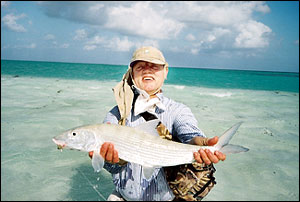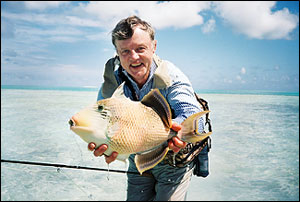back to MUSEUM
 |
 |
The 1998 natural preservation designation of the two coral atolls/flats south of St. Alphonse Island in the Seychelles exemplifies MāHUNT’s philosophy and purpose of limited access to pristine properties/habitat with minimal disturbance, but maximum direct education of the importance of legal ethical hunting (fly fishing is just another holy hunt). Natural preservation does not mean no human involvement. It means intelligent limited human interaction that teaches humans to value the resource while diminishing it minimally. This self-interest ensures caretakers who protect the wild and therefore ensure its perpetuation. The fragile highly biodiverse habitat of the Indian Ocean north of Madagascar and just south of the equator that provides economic benefit for caretakers is more likely to be preserved than natural preservation areas unprotected from poachers with absentee or name only caretakers. Wildlife has to pay to stay.
Only twelve rods (active fisherpersons) are allowed under live-release flyfishing within an area surrounding the atolls. The introduction of economic gain from such saluting/sustaining fly fishing tourism make the many diverse species of game fish more valuable than the mere taste and weight of their cooked flesh. MāHUNT espouses that someone must “pay for” wildlife either through habitat introduction/preservation/enlargement/enhancement or through minimized if not complete elimination of poaching or taking of wildlife. The revenue to the flyfishing guide service and to the nearby St. Alphonse Resort from up to twelve (12) fly fisherpersons and their guests encourage them to guard the resource. Since 1999 guides turned away sea turtle poachers, trawlers, and islanders fishing for subsistence from the two atoll’s near pristine environment, because they had an economic incentive to save the wild stay fish for live-release paying fly fishing clients.
A 2002 fishing expedition from St. Alphonse Island traveled south for over one week of fly fishing to the Farquhar Group of atolls that are uninhabited and over fifteen (15) miles across. This group of atolls had similar natural preservation designation to that of those south of St. Alphonse Island. During their stay, the group saw only one shark, caught only one trevally, and saw no bonefish in a habitat that rivaled the atolls south of St. Alphonse Island. Without economically interested caretakers to protect Farquahr’s wildlife, it was decimated. Environmentalists obviously had insufficient incentive to guard its resources by sitting on a boat all year around and turning poachers away.
St. Alphonse Island is known as the most prolific place in the world to flyfish for large bonefish. The picture at the top left of this section shows a typical seven (7) pound bonefish fly live-released by hunting on the coral flats (shown in the background before they descend to the depths farther in the background inside the atoll) with a small weighted fly carefully cast in front of the moving or next to the tailing bonefish (that sinks out of the view of the bonefish) and then is gently retrieved when the bonefish is close enough to hunt its prey (the fly).
The flats and the water on either side of the atoll are a killing-zone, except by flyfisherpersons. Bonefish eat shrimp and crabs. Milkfish eat plankton. Blue fin trevally eat any animal that moves. Sharks and giant trevally eat bonefish, bluefin trevally, and milkfish. Bonefish, bluefin trevally, and milkfish survive only because of their speed and awareness. This also gives them appeal to flyfishing live-release hunters. As Tom Jarcho was quoted when trying to make people understand the real “wild” world and why live-release flyfishing should be practiced only in certain special cases so that flyfishing is not divorced from its real hunt aspects:
“The outstanding characteristic of every body of water I have ever fished was that every creature in it was trying to kill and eat other organisms and avoid being eaten itself… yet Pete Bodo insists on chastising fisherman who kill fish. He does not understand the difference between a trout stream and an aquarium.”
George Reiger in the September 2002 “Field and Stream” repeats Ben Franklin’s warning to his fellow fighters for freedom: “We must all hang together, or assuredly we shall all hang separately” as it relates to live-release flyfisherpersons, hunters and trappers. He continues: “This is what’s fundamentally wrong about the otherwise worthy practice of live-release. When raised to a universal, all-embracing moral principle, such angling perverts fishing from a predatory act into an artistic or competitive act. In so doing, it distorts the even more important perception of man’s role in nature, one can be in nature and not affect nature. Worse still, it pretends that such noninvolvement is the moral ideal. …live-release…changes…the ethos of fishing from a predatory activity into a virtual activity, a game with nature, and not a real participation with nature.”
Innovation and creativity can also enhance a near pristine environment. Before 2002, milkfish were thought untargetable by all fisherpersons. One team of observant conservationist guides saw pods of up to fifty (50) milkfish (generally 20-30 pounds) vacuum the minuscule plankton underneath the surface with oval open mouths in a slow ballet. A dry fly that mimicked a small mat of plankton proved unsuccessful. A heavier hook with just a smattering of plankton like fluff finally produced the first milkfish taken by fly ever in the world in the spring of 2002. Tremendously long delicate casts were required with an eleven-weight flyrod to a point in front of the approaching or quartering pod. The fly was dead-drifted until it sank about one foot from the surface. If the line moved, a slip strike hooked the milkfish in the mouth (no foul hooking occurred). The picture on the right at the beginning of this section features James A. Schneider on Friday, January 17, 2003 with a twenty-eight pound live-released milkfish that would have been a new IGFA World Record, except that the guiding team would not let the fly be submitted to the IGFA so that others could learn the characteristics of the fly and thereby lessen their economic advantage.
This milkfish was the third hook-up in two days of flyfishing for them in 2003 by James A. Schneider. The first broke a twenty-pound tippet (probably scraping it on the coral on the bottom) after ten (10) minutes of fight. The second merely came unhooked after about fifteen (15) minutes of engagement.
The above pictured twenty-eight pound milkfish was probably among the first twenty client-taken fly live-released milkfish in the world. The video of the first run of the milkfish by the guide over James A. Schneider’s shoulder is probably the first and only video that captured three sailfish-like jumps of a milkfish hooked by fly where the milkfish came completely out of the water about 100 yards from the angler. The twenty-eight pound milkfish’s first run was an explosion of over 100 yards that was faster than that of a bonefish on the flats. After the next four or five speedy runs of thirty or forty yards against the eleven weight rod (bonefishing is generally done with a six or seven weight rod for a four to seven pound fish), the twenty-eight pound milkfish began to sound towards the depths. Constant pressure (but not so hard to burst the twenty pound tippet) was required in the 84 degree calm beating sun to try to bring the milkfish to net. As the milkfish tired it came back to the surface. As the forty minute mark of the fight passed and a dripping brow meant stinging eyes and aching arms, the milkfish met the net.
After pictures, video, and removal of the secret fly from the corner of its mouth, the new rival to tarpon on a fly was live-released into the Indian Ocean unharmed. As more flyfisherpersons travel to the Seychelles to pursue muscular milkfish by fly, their direct education and stories to others will advance the cause of saving near pristine habitat through limited use while granting incentive to the local caretakers to preserve delicate biodiverse habitat.
Milkfish are pen raised for food in southeast Asia as a delicacy. The new innovative fly fishing technique will elevate milkfish to pinnacle-fish over the whole world and add voices to ensure that trawlers and poachers do not dramatically deplete them.
 |
|
 |
 |
Beside bonefish, milkfish, bluefin travally, giant trevally, sharks, pompano, and barracuda, the flats feature triggerfish in three varieties. Slowly feeding for crabs while tailing on the flats, but never too far from the edge (unlike bonefish that swarm over the entire flats, many times a mile or more from the deep edge), triggerfish offer a far different fly casting challenge. Since they are almost stationary when tailing, a crab fly (larger and more noisy than the smaller flies used for foraging and ever moving bonefish) must be cast just far enough in front of them to be seen, but delicately enough so they are not startled. The Picasso triggerfish featured in the top picture displays impressionistic colors, stripes, and slashes. It survives because its top fin looks like a trigger and can be locked in place straight up. This means that a predator has to worry about it viscera being pierced by this spear point if swallowed. This very fast fish (about the same as a bonefish) can feed more deliberately with less speedy agitation because speed is not its main survival mechanism, rather it piercing personality.
The giant triggerfish on the left above and the yellow margin triggerfish on the right were both about seven pounds. Upon taking the fly, they often would swim directly backward unlike any other fish (notice the large wavy fins on top and on the bottom towards the back of the fish). Without warning, they then would race towards the edge of the flat and dive into the depths cutting the tippet on the razor sharp coral. The challenge beyond hooking them, is to hold them on a screaming reel to try to turn them before they reach releasing razors. The featured yellow margin triggerfish was the twelfth of its kind that I hooked (with the first eleven finding the coral’s edge). Great care was required when handling the fish, since its two inch long upper and lower teeth (used to crush hard shelled crabs) could clamp onto an appendage for what would seem permanently. These triggerfish were also perceived to not be fly-taking friendly and rarely caught until about 2002 when the guide group began to target them. They certainly rival bonefish in challenge, speed, and strength.